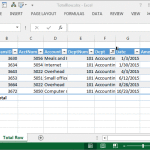Excel University Blog
Read on for in-depth articles, tutorials, and videos. Search or browse for specific topics. Be sure to subscribe if you'd like to be notified when we write something new.
Tables
Previously, we explored using the INDIRECT function to refer to various tables in a workbook. In this follow-up post, we’ll expand the discussion and refer to individual table columns. Objective Let’s start with our objective. We have several tables in a workbook. They have the same structure and store department data. For example, here is…
Read MoreIn this post, we’ll allow the user to select a table name from a data validation drop-down and our Excel formulas will operate on the values from the selected table. Thanks to Neelima for asking about this technique! Objective Before we get too far, let’s be clear about our objective. We have several data tables in…
Read MoreThe table feature introduced in Excel 2007 is amazing and has nearly eliminated the need to build dynamic named ranges since tables auto-expand. Beyond auto-expansion, tables offer numerous other benefits, including, structured references which allow us to refer to an area within the table, such as a specific column. In this post, we’ll examine a method…
Read MoreIn this post, we’ll explore a method to allow a user to select an item from a drop-down list and then use formulas with the VLOOKUP function to retrieve multiple values from the related item table. Objective Before digging into the mechanics, let’s review our objective with an example. We would like to allow our…
Read MoreIn this post, we’ll create two data validation drop-down cells that provide the ability to select From and To dates based on the transaction dates stored in the source data. This will ensure that the date selections fall within a valid range of dates, that is, those months with data in the table. This technique…
Read MoreIn this post, we’ll explore a method for generating a drop-down that contains a unique list of choices derived from a table column with duplicate values. Objective Before we get started on the mechanics, let’s take a look at what we are trying to achieve. We have a data table that is exported from our…
Read MoreIn this post, we’ll explore three methods for transposing data in Excel. The first method can be used when you just want to quickly to transpose the values manually. The second method can be used when you want formulas to perform the transposition automatically based on the labels. The third method can be applied when…
Read MoreThe Table feature of Excel remains one of my favorites. This post explores one very specific aspect of the feature, the total row. Overview One of Microsoft’s greatest gifts of Excel 2007 was the introduction of the table feature. It allows us to convert an ordinary range into a table (Insert > Table, or, Ctrl+T).…
Read MoreHi guys! Just wanted to draw your attention to my April 2014 Journal of Accountancy article that discusses the power of mapping tables. If you’ve not experimented with this technique, it is worth checking out. In summary, a mapping table sits between the data and report sheets and enables you to translate labels and aggregate…
Read MoreThis post explores macro-free methods for using Excel’s data validation feature to create an in-cell drop-down that displays choices depending on the value selected in a previous in-cell drop-down. Overview As with just about anything in Excel, there are several ways to achieve the goal. This post explores three such solutions, and if you have a…
Read More- « Previous
- 1
- 2
- 3
- 4
- Next »










